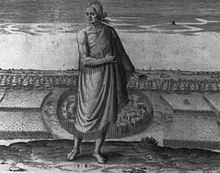
An aged Native man from Pomeiock, c. 1590.
The Pamlico (or Pomouik) were a Native American people of North Carolina. They spoke an Algonquian language also known as Pamlico or Carolina Algonquian.
The Pamlico Indians lived on the Pamlico River in North Carolina. Named after them were Pamlico Sound, the largest sound in North Carolina, and Pamlico County. They are one of the most southerly Algonquian tribes on the Atlantic seaboard, and the most southerly one for which scholars collected a vocabulary.
In 1695, smallpox, called "A great Mortality", devastated the Pamlico and neighboring Algonquian communities and reduced their populations. In 1701 the explorer John Lawson noted their Algonquian language and vocabulary (Lawson, 1860). By 1710 the Pamlico people were so limited that they lived in a single small village.
By 1709 the total North Carolina Algonquian population was down to some 600 from at least several thousand at the time of English encounter. The Tuscarora War, 1711-1713, claimed more fatalities among the Algonquian allies than of the Tuscarora. In the late stages, the Tuscarora turned on some of their allies. They likely incorporated some of the Pamlico as slaves. By the end of the century, only a handful of Algonkians remained.
With the decrease in numbers came the loss of tribal lands. Thus, the Weapemeoc Indians sold their lands on Albemarle Sound in 1660 and 1662 and started to move to the interior. By 1697 they complained against the encroachments of white settlers in their new location. The English assigned a reservation on Bennetts Creek to the Chawanokes (Chowan) before 1700; they reduced its sized from 12 to 6 square miles (16 km2) by 1707; the Chowanoke sold off land in 1713. After the Tuscarora War, the Machapunga also were assigned to a reservation. Other groups on the Pamlico Sound joined either the Machapunga or the Tuscarora.
With growing white presence in eastern Carolina, more products of European origin were introduced to the Indians. Guns were regularly used instead of bows and arrows during the eighteenth century. Iron hatchets had likewise replaced wooden clubs. English clothes were also widely used by the Indians. The Roanoke chief had an English-style house built in 1654.
Other practices persisted through the nineteenth century, including the women making baskets of rushes and silk grass. They decorated them with woven-in life motifs. The Pamlico created distinctive dugout canoes, and traveled extensively. Pamlico artifacts have been found as far away as the North Atlantic.
They ate corn, fish, and other agricultural vegetables and fruits. Besides hunting and agriculture, the coastal groups still relied much on fishing and shellfish gathering, drying the products for preservation on reed hurdles over an open fire or in the sun. Sturgeon was not used as a food by the Indians along the coast. Cattle raising is documented for the Paspatanks around 1700 (Lawson 1709). The Tuscarora War disturbed the economic balance of many of the Algonquian groups: the fields of the Machapunga and their allies were destroyed by the English. The Hatteras were prevented from planting by their enemies, and in 1714-1715 needed supplies from the colonial authorities to survive.
Political organization with hereditary chiefdoms was still functioning around 1700. Chiefs' corpses were buried in the temples as before. Commoners could purchase the right of burial in the temple precinct with enough money. Shell beads (wampum) served as money, for example, to compensate victims of crimes.
Marriage restrictions that prohibited marrying first cousins made it difficult to find mates within rapidly shrinking communities. Resulting marriages into other tribes certainly strengthened intertribal bonds.
The huskenaw rite appears to have been used as an initiation for both boys and girls. It was held around Christmas and lasted for five or six weeks, during which the adolescents were separated in a special building outside the village. There were some colonial reports that two of 50 families among the Machapungas practiced male circumcision, but this was not typical of the Native Americans.*
IK
Kin 62: White Planetary Wind
I perfect in order to communicate
Producing breath
I seal the input of spirit
With the planetary tone of manifestation
I am guided by the power of heart.
Chakras can be thought of as switches we turn on when the chakras inside the planet are switched on. Then shadows dissolve and a new world is revealed.*
*Star Traveler's 13 Moon Almanac of Synchronicity, Galactic Research Institute, Law of Time Press, Ashland, Oregon, 2016-2017,
The Sacred Tzolk'in
Manipura Chakra (Limi Plasma)





No comments:
Post a Comment